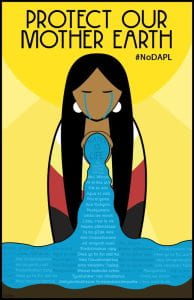 We see across cultures that humans have always had a large connectivity with land and environment. Defense and protection of the environment is synonymous with protection of resources and people. Native American cultures spanning from the southern parts of Chile and Argentina to northern Canada are deeply rooted in the physical land. Practicing culture and community in the age of industrialization and capitalism has become almost impossible. The 2015 “Gendered Impacts series” delves deeper into the connection between land violence and gender violence drawing parallels between the treatment of the environment and the treatment of the women who live there. These communities have been rocked by the intrusion of mining and other industrial facilities that see an “increase of violence against women due to the increase in revenue, that leads to the increase in alcohol and drug abuse, which leads to an increase of domestic violence” this paired with how many “women working at the mine were mainly working as house cleaning staff for a predominantly male workforce and so this did make them very vulnerable to sexual harassment” (KAIROS Canada). So not only have they been displaced from their land, but women in particular face violence on the soil where they were once safe. This displacement has huge community based issues, how do they practice a culture that is environment based when they have lost access to “traditional hunting grounds” and when “important animals have changed their migration routes” (KAIROS Canada)?
We see across cultures that humans have always had a large connectivity with land and environment. Defense and protection of the environment is synonymous with protection of resources and people. Native American cultures spanning from the southern parts of Chile and Argentina to northern Canada are deeply rooted in the physical land. Practicing culture and community in the age of industrialization and capitalism has become almost impossible. The 2015 “Gendered Impacts series” delves deeper into the connection between land violence and gender violence drawing parallels between the treatment of the environment and the treatment of the women who live there. These communities have been rocked by the intrusion of mining and other industrial facilities that see an “increase of violence against women due to the increase in revenue, that leads to the increase in alcohol and drug abuse, which leads to an increase of domestic violence” this paired with how many “women working at the mine were mainly working as house cleaning staff for a predominantly male workforce and so this did make them very vulnerable to sexual harassment” (KAIROS Canada). So not only have they been displaced from their land, but women in particular face violence on the soil where they were once safe. This displacement has huge community based issues, how do they practice a culture that is environment based when they have lost access to “traditional hunting grounds” and when “important animals have changed their migration routes” (KAIROS Canada)?

This connection between personal identity in land is a concept we talk a lot about in ecofeminism. Looking back on “Touching the Earth” by Bell Hooks and “Knowing Our Place” by Barbara Kingsolver we can see a more intersectional framework connecting nature and identity. Hooks speaks to the similarities between the “Native americans and African people shared with one another a respect for the life-giving forces of nature, of the Earth” adding that “sharing the reverence for the Earth, [African] and [Native] people helped one another reme mber that despite the white man’s ways, the land belonged to everyone” (Hooks 364). This binary idea of ownership was something that wasn’t present in Native or African cultures until intervention from colonials. Kingsolver also touches on this idea of abstract ownership and mourns the degradation of naturality in our society saying “With all due respect for the wondrous ways people amuse themselves and one another on paved surfaces, I find this exodus from the land makes me unspeakably sad. I think of the children who will never know intuitively, that a flower is a plant’s way of making love, or what silence sounds like or that trees breathe out what we breathe in” (Kingsolver 2). This line instantly made me think of the treatment of Indigenous land in the Americas. Kingsolver hits hard on this idea of generational experience and how the experience of the generations will be vastly different especially in cultures that rely heavily on the environment.
mber that despite the white man’s ways, the land belonged to everyone” (Hooks 364). This binary idea of ownership was something that wasn’t present in Native or African cultures until intervention from colonials. Kingsolver also touches on this idea of abstract ownership and mourns the degradation of naturality in our society saying “With all due respect for the wondrous ways people amuse themselves and one another on paved surfaces, I find this exodus from the land makes me unspeakably sad. I think of the children who will never know intuitively, that a flower is a plant’s way of making love, or what silence sounds like or that trees breathe out what we breathe in” (Kingsolver 2). This line instantly made me think of the treatment of Indigenous land in the Americas. Kingsolver hits hard on this idea of generational experience and how the experience of the generations will be vastly different especially in cultures that rely heavily on the environment.
-KAIROS Canada. “2015 Gendered Impacts series (4): Land is Identity (2:28).” YouTube, 2016, https://www.youtube.com/watch?v=LopcPrSvDBw. Accessed 2 April 2023.
-KAIROS Canada. “Violence Against The Land (3:02).” YouTube, KAIROS Canada, 2016, https://www.youtube.com/watch?v=Mlbc2dD0gP0&t=28s. Accessed 2 April 2023.
